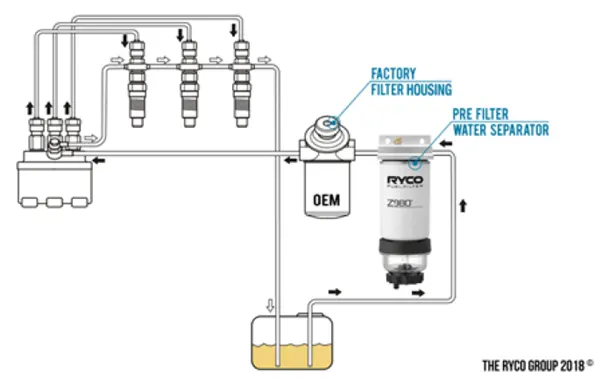FUEL WATER SEPARATOR TECHNICAL
Fuel Water Separators – How do they work?
Diesel fuel naturally contains more impurities than regular unleaded petrol, meaning that optimum filtration as an absolute must, especially if you work your vehicle hard or travel to parts of the country where the only fuel available might be questionable in terms of quality. Whilst the OEM fuel filter does its job of filtering a large amount of fuel contaminants before it reaches the engine, it does have its limits and can prove ineffective against water and other particulates. The Fuel Water separator acts as an added line of defence for your vehicle’s fuel system, filtering water and particulates from the fuel before it reaches the fuel filter, ensuring only a flow of clean fuel reaches your engine.
Water Contamination
Water contamination in your vehicle’s fuel system can prove detrimental to engine health. When emulsified in fuel, water can lead to a number of engine-harming issues. Water contamination can lead to corrosion of metal components, as well as develop microbacterial growth within the fuel system, both of which cause decreased levels of durability and performance, and if left undealt with can lead to severe damage to both the engine and fuel system.
This is where the Fuel Water Separator comes into play. The Fuel Water Separator serves as a purpose-built filter that works to isolate and collect water before it can reach vital fuel delivery components and ultimately, the engine. Your vehicle’s OEM fuel filter is typically rated to 4-6 microns of filtration, lacks a visual water trap and may not be accessible enough to drain, meaning you won’t know of any water contamination before it’s too late.
Water Separation Operation
With the Fuel Water Separator installed, it becomes the first point of contact for all the fuel from your vehicle’s fuel tank. Fuel flows through the first stage of the Fuel Water Separator and travels through the centre of the separator unit to the in-built water trap. Any contaminants denser than the fuel itself i.e. water, falls to the bottom of the trap, with the lighter fuel being pushed up into the second stage of the Fuel Water Separator. The fuel rises through the treated media surface of the separator unit, which works by separating water from the fuel through its repellent surface. The water particles form large droplets then end up falling back into the water trap. Any solid contaminants left in the waterless fuel are filtered through the filter element of the separator unit.
Typical filtration media used in Fuel Water Separators is either a hydrophobic barrier media, such as silicone treated cellulose, or a hydrophilic depth coalescing media, such as glass micro-fibre.
Best Practices for Fitment
When installing a Fuel Water Separator to your vehicle, it’s important to consider its install location. The Fuel Water Separator is best installed within the engine bay due to the space and protection offered underneath the bonnet. Installing your Fuel Water Separator in your engine also allows for easy access when viewing and draining the water trap.
Fuel Water Separators are designed to be fitted as a series installation. This involves fitting the separator unit in-line with the OEM fuel filter. In this type of installation, fuel must pass through the Fuel Water Separator and OEM fuel filter before it reaches fuel delivery components such as the injectors to ensure only clean fuel reaches the engine.
The Ryco Fuel Water Separator comes equipped with a 10 micron (Nominal at 99% efficiency) rated fuel filter. This allows the filter to catch 99% of the microbial bugs, dirt or other particle matter down to a size of 10 microns.

Pre or Post OEM Filter?
When installed, your Fuel Water Separator acts as your fuel system first line of defence against contaminants. For this reason, it’s important that the separator unit is installed before the OEM fuel filter. This allows the Fuel Water Separator to catch larger particulates and moisture before it reaches the OEM filter, effectively lightening its workload allowing it to operate more efficiently.
Installing your Fuel Water Separator before the OEM filter also works to protect and extend the life of your OEM fuel filter by preventing bacteria growth and corrosion of the OEM filter media as well preventing any emulsified water from entering the OEM filter.
If installed after the OEM filter, this may open yourself to issues such as filter blockage, which in-turn may result in more frequent changes and in more extreme cases, even engine power loss.
This is why Ryco recommends all fuel water separators be fitted before the standard filter.
Share this via:
Haven’t found the right part?
Try searching again or find your nearest Ryco reseller.